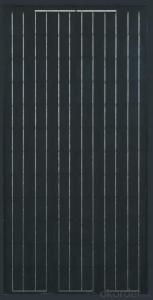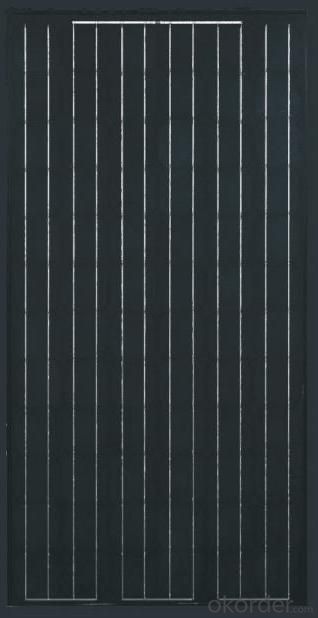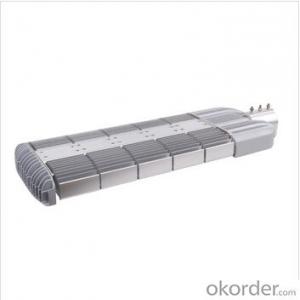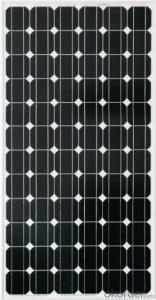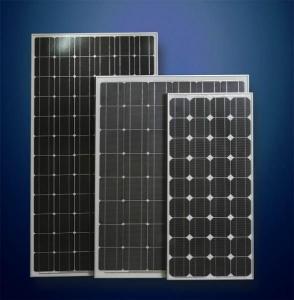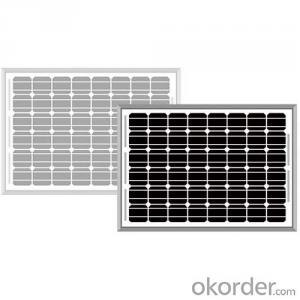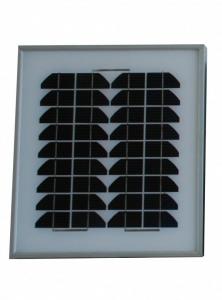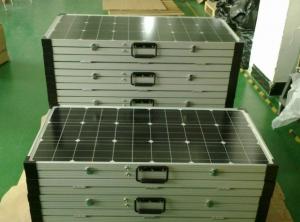Hyundai Solar Panels - Monocrystalline Solar Module 194w
- Loading Port:
- China Main Port
- Payment Terms:
- TT OR LC
- Min Order Qty:
- -
- Supply Capability:
- -
OKorder Service Pledge
OKorder Financial Service
You Might Also Like
Solar Monocrystalline (210W-225W)
Introduction of Solar Monocrystalline (210W-225W)
Solar modules use light energy (photons) from the sun to generate electricity through the photovoltaic effect. The majority of modules use wafer-based crystalline silicon cells or thin-film cells based on cadmium telluride or silicon. The structural (load carrying) member of a module can either be the top layer or the back layer. Cells must also be protected from mechanical damage and moisture. Most solar modules are rigid, but semi-flexible ones are available, based on thin-film cells. These early solar modules were first used in space in 1958.
CNBM Solar photovoltaic (PV) Panel is designed for large electrical power requirements. It is the optimal choice for both on-grid and off-grid power systems. CNBM Solar panel offers high performance of power per square foot of solar array. Monocrystalline silicon(c-Si): often made using the Czochralski process. Single-crystal wafer cells tend to be expensive, and because they are cut from cylindrical ingots, do not completely cover a square solar cell module without a substantial waste of refined silicon. Hence most c-Si panels have uncovered gaps at the four corners of the cells.
Characteristics of Solar Monocrystalline (210W-225W)
I. Solar Cell : High efficiency crystalline solar cell. Even if under the weak light, the solar module can produce maximum power output.
II. Tempered glass (toughened glass): Anti-reflecting coating and high transmission rate glass increase the power output and mechanical strength of solar module.
III. EVA and TPT: Using high quality EVA and TPT to prevent destroying and water.
IV. AI frame: Without screw, corner connection. 6 holes on the frame can be installed easily.
V. Junction box: Multi function junction box with water proof.
VI. Long lifetime: ≥25 years; Less power decrease.
VII. Good performance of preventing from atrocious weather such as wind and hails.
VIII. Resisting moisture and etching effectively, not effected by geology.
IX. The certificate issued by international authority: UL, TUV, IEC, VDE, CE.
Standard Test Conditions of Solar Monocrystalline (210W-225W)
The opto-electrical specifications shown below are stabilized values being measured at Standard Test Conditions, Irradiance: 1000W/m2, Spectrum: AM1.5 at 25°C, The info below is subject to manufacturing tolerances. Where appropriate minutes of measurement are available and are used for the dimensioning of the installation.
Advantages of Solar Monocrystalline (210W-225W)
• CNBM Solar performance guarantees for 25 years
• 10 years guarantee for workmanship
• Timeliness of delivery
• Quality Products certified (TÜV, UL, CE, VDE, ISO)
CNBM International Corporation's products including Monocrystalline Solar Panel, Polycrystalline Solar Panel have received and enjoyed famous reputation in many countries and regions in the world .As a solar panel manufacturer in China, we strive to provide our customers with excellent service, superior products and unmatched value.
- Q: Are solar panels environmentally friendly?
- Yes, solar panels are environmentally friendly. They produce clean, renewable energy by harnessing the power of the sun, reducing the reliance on fossil fuels and minimizing greenhouse gas emissions. Additionally, solar panels have a long lifespan and can be recycled at the end of their life, making them a sustainable and eco-friendly energy solution.
- Q: im aware i dont fully understand. but with what i do. if P = iv, and current changes with voltage, whats the point of changing either. if in any cicumstance, you end up with the same wattage, how does changing either effect a solar setup. (2v panel vs 24v)thanks in advance. explain in laymans if you can.
- The choice of solar panel voltage comes down more to what the panels will be connected to. You're right that power can remain the same at the different voltages. Higher input (panel) voltages are sometimes used in inverter systems to reduce the effect of voltage draw-down. 2v panels (about 20v open circuit) work well for charging 2v batteries, connected in parallel, through a charge controller. For use of a grid-tie inverter, higher input voltages are sometimes used to reduce the effects of draw-down. You want to select and wire (parallel vs. series) your panels based on the input voltage requirement of the load, whatever it may be.
- Q: Can solar panels be installed on south-facing windows?
- Yes, solar panels can be installed on south-facing windows as long as the windows receive sufficient sunlight throughout the day.
- Q: Can solar panels power an entire home?
- Yes, solar panels can indeed power an entire home. With advancements in technology and improved efficiency of solar panels, it is possible to generate enough electricity to meet the energy demands of a typical household. Additionally, by installing a battery storage system, excess energy generated during the day can be stored and used during nighttime or cloudy periods, ensuring uninterrupted power supply.
- Q: All I ever heard is how easy it is to get solar panels for a persons home. I live in Arkansas and to do my house it would cost 25000 that I dont have and No state incentives. So where do I go and get these free solar panels? Thanks for the help
- Sorry this is so long. I live in north west arkansas. I have solar on my home. I installed them myself. Did not cost me anywhere near 25 grand. Solar will pay you back if you get incentives or not. I have said this a hundred times but people just don't seem to understand or can't do the math. You are renting from the public utility. You have nothing in the end but a stack of payment stubs. There is no way to get a return on your investment. You paid them money and have nothing. Nothing at all .. Well maybe good service. But still nothing. If you check it out most solar electric systems last 30 years or longer. If your electric bill is 00 dollars a month. do the math. 00 dollars a month for 30 years is $36,000 dollars you would normally pay the public utility. So why not buy your $25,000 system, you just made $0,000 right there on the spot. Now add in 3.5% cost of living per year for each year for the next 30 years on that 35,000 you pay the public utility. Then you have to keep in mind you do not pay taxes on any electric you make yourself. You do not pay fees on your own power. You do not pay the cost of fuel incresses every time the price of oil goes up. In the end you saved $00,000. So it is free even if Arkansas don't give free handouts like other states. I even know people who say they are waiting for some one to make a cheaper solar module. That will not happen because even if they make it for half the cost (like evergreen is doing) it will still be sold at standard market value not production cost. The real problem with solar is it is hard to come up with the upfront cost. But renting solar panels is comming but that is the same as just renting power from the public utility. I wish you luck but it will be a while before Arkansas will make any moves on renewables. They just in 2007 made it law that the public utilities have to let your roll your net metering over to the next month if you over produced.
- Q: What is the average size of a solar panel?
- The average size of a solar panel is typically around 65 inches by 39 inches, or approximately 5.4 feet by 3.25 feet. However, the actual size can vary depending on the manufacturer and the specific model of the solar panel.
- Q: Can solar panels be installed on bridges or highways?
- Yes, solar panels can be installed on bridges or highways. This is known as solar roadways or solar bridges. These panels can generate electricity by harnessing sunlight and can be integrated into the surface of bridges or highways. However, the feasibility and practicality of such installations may vary depending on factors like structural considerations, cost, maintenance, and local regulations.
- Q: So idk how to connect a solar panel to a battery ...is it like a series connection from the solar panel to the battery, or a parallel connection from solar cell to battery? (to charge) please and thank you
- it depends how big the panel is. a small trickle charger (like a 2W panel with built-in diode), just connect + to + and - to - (parallel) to trickle charge the battery. The diode will keep the batter from discharging through the panel when there is insufficient sunlight. for a large panel (like a 220W 24v panel), you best go through a charge controller. the charge controller has 2 leads for the solar panel input, 2 leads for the battery connection and 2 leads for the 2v load. just follow the instructions to connect the panel and battery to the controller, and MAKE SURE YOU USE THE REQUIRED FUSES. very straightforward stuff -- just RTFM
- Q: I want to build a standalone wifi repeater -- powered by the sun. The problem is how much solar power and how big of a battery?net draw 4.5v @ 0.66A with loadnet draw 4.5v @ 0.60A no loadI'm assuming the best choice would be a 6v battery with a a couple diodes in series to induce ~.5v drop. Then, I need something to charge it -- I found 2v 6w solar chargers in the automotive section of Sears and 6v 2w solar chargers in the marine section of Dick's Sporting Goods.How many solar panels and what capacity batteries should I use? Is this the best method or should I use a voltage regulator and go with 2v batteries?I need this to be as cheap and simple as possible...
- You won't get very far with THAT lash-up. First of all.. WHY would you want to use diodes to drop the voltage.. they DRAW CURRENT and that is something you don't have to spare. That draw of (660 ma) comes out to just under 3 watts. You DO KNOW that you can get that 4.5 Volts by driving a NAIL into the THIRD CELL in a 6 Volt wet cell battery... right? and for what you are doing, you have more current available with a 6 volt battery than a 2 volt battery. Anyway, you could use two 6 Volt batteries and tap them at the 4.5 volt point then tie them in parallel, but you could still use the 6 volt solar panel to charge them. Trying to use an inverter is just an exercise in futility.. With TWO of the LARGEST DEEP CYCLE BATTERIES you can buy at AutoZone running in Parallel and being charged by solar panels.. if you hook a 75 watt inverter to them, they will go flat in about 4 hours of use during the night. This is not rocket science. Back when cars were changing over from 6 volts to 2 volts, I powered up more than one 6 volt car radio off a 2 volt battery... when you grow up as poor as I did.. you get inventive. I later used the same trick on the 24 volt electrical systems the Jeeps were using, to power up clandestine repeaters in places where no repeaters should have been. About 25 years ago I was living in the Denver area and built up a 0 watt 2 meter repeater on a split channel and took it up to Mt. Evans during the summer and hid it in a pile of rocks. I used tone control, so we were the only ones using it and, as I said, It was a split channel.. so it wasn't on a regular repeater channel. That thing was still running when I moved from the Denver area about 3 years later and for all I know, It's still up there on Mt. Evans (find the Brittlecone Pines and look towards that small peak about a mile to the west)
- Q: I'm looking into buying solar panels, there are all kinds of ranges of energy output...but my question is, when ti says...say 50 watts of power...does that mean 50 watts a day, an hour, a minute, what?
- A 50-watt rating means the panel will produce 50 watts as long as the standard conditions are maintained. So if you had this bright sun and cool temperatures for 6 hours, the panel would deliver 50 x 6 = 900 watt hours, or a little shy of kilowatt-hour. Kilowatt-hours (kWh) is the reading on your electric bill. However, like most advertising, the 50-watt number is not realistic. They assume that the air surrounding the panel is very cold. 25 watts is a better number to use for this size of panel for engineering purposes.
Send your message to us
Hyundai Solar Panels - Monocrystalline Solar Module 194w
- Loading Port:
- China Main Port
- Payment Terms:
- TT OR LC
- Min Order Qty:
- -
- Supply Capability:
- -
OKorder Service Pledge
OKorder Financial Service
Similar products
Hot products
Hot Searches
Related keywords
